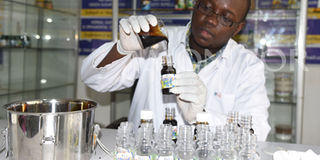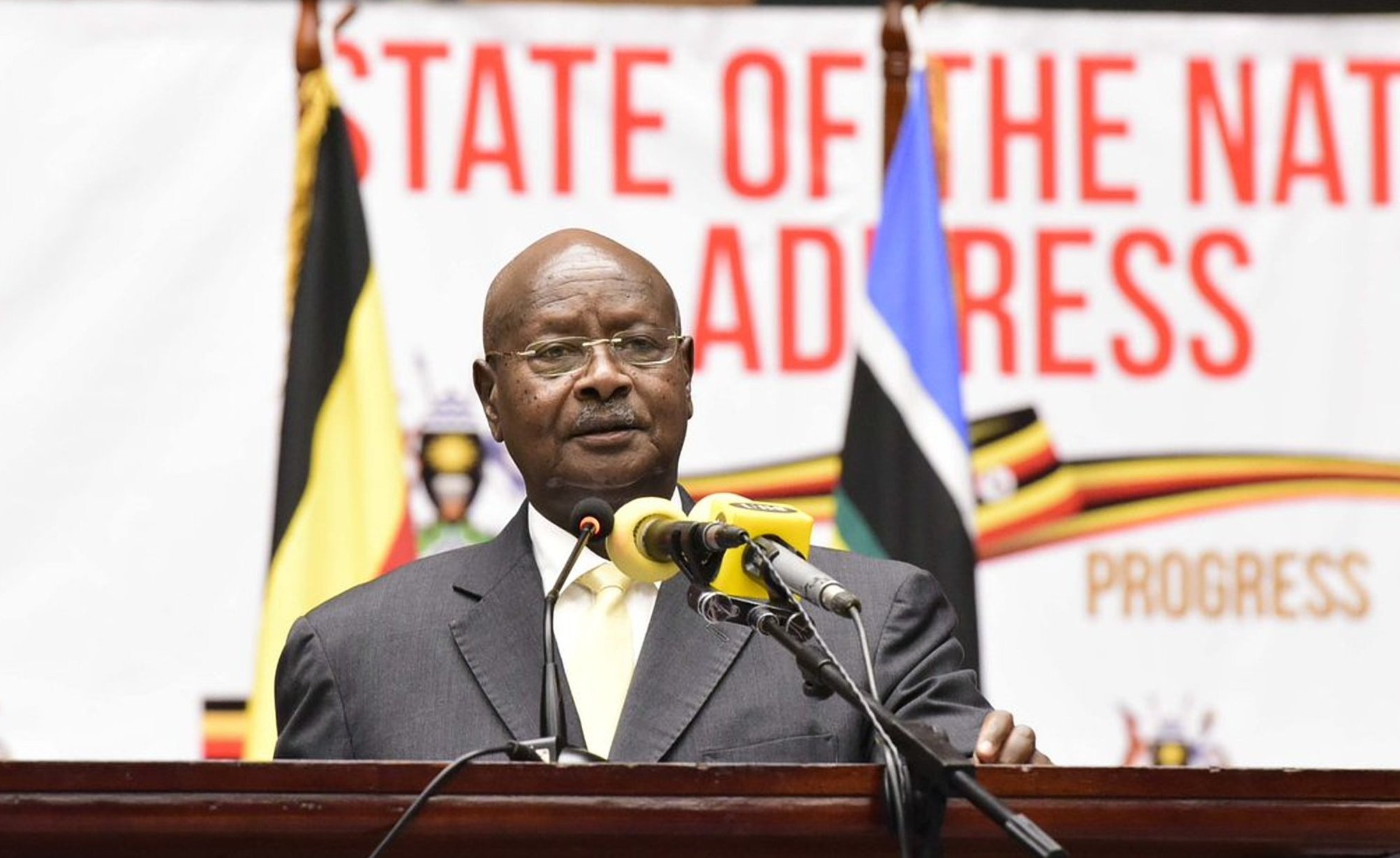Prime
Nyanzi extracts oil from coffee

What you need to know:
- Coffee oil can be produced from green (unroasted) or roasted beans. There are a number of aromatic coffee oils and extracts on the market including those marketed as coffee essential oil. Sometimes, coffee oil is produced by infusing coffee beans into a vegetable oil to produce what is known as an infused oil.
Coffee farmers have upped their game ever since the controversial Enrica Pinetti coffee deal surfaced.
Not to be left out, many are now venturing into diverse coffee value addition by-products to meet the demand that had created a vacuum that the Italian investor, sought to address.
Value addition
To agronomist Julius Nyanzi from Prof Bioresearch, Uganda can reap alot of money through exploiting the various coffee value addition options.
Nyanzi’s latest value addition innovation is the coffee oil processing that he believes has an abundant local and global market.
“The coffee business is evolving fast, that is why I thought about a by-product that was not on the market,” Nyanzi says.
It took him two years to come up with the coffee oil processing formula and after thorough medical research and approval, Nyanzi has delivered an ointment that is medicinal, aromatic and can be used in beverages.
The coffee oil, according to Nyanzi, can also be blended to produce coffee honey and also produces shrubs for women’s facial beauty if you add sugar or salt to remove dead skin. A few drops of coffee oil are enough to make one cup of hot drinking coffee.
Impressive numbers
To produce one litre of coffee oil, one needs only five kilogrammes of dried coffee. One litre of oil costs Shs200,000 at Nyanzi’s Equatorial Mall Prof Bioresearch production centre which implies that a farmer earns almost nine-fold from what he would have got from just selling dried ‘Kase’ coffee beans. All types of coffee are recommended for the production of coffee oil which makes it a lucrative business for all players. It takes five kilogrammes to produce one litre, a sack of 100 kilogrammes gives you 20 litres, which is about Shs4m in earnings.
Extracting tools
Nyanzi willingly shares his knowledge with those interested in this venture. He sells the domestic oil extractor machine at Shs5m, the commercial machine at Shs15m and the industrial machine at Shs50m.
“I have a credit system for the machines and in most cases, I encourage prospective farmers to form associations or groups to raise capital or credit to purchase these machines,” he says.
How to extract oil
You start by harvesting red ripe coffee beans. Dry them in a solar dryer or biomass dryer which dries for 24 hours. You get a dehusker, remove the top coat, take it for grinding and then extract oil. Alternatively, you can first dry the red ripe coffee beans, remove the husks dry again, and then press cold on the machine.
The most important aspect is regulating the moisture, above 13 percent you can get powder instead of oil if you cold press and if you have moisture content below 13 percent you get porridge-like substance.
“The process is very simple. I also help you in controlling moisture content and advise you not to dry the coffee beans directly in the sun,” says Nyanzi.

If you fail to regulate the moisture content, you can never get oil. If you cannot buy the moisture metres, you can resort to the cracking method - that is you crack coffee beans and if they splits open that means the beans are at the recommended 13 percent moisture content.
Process
Coffee beans contain natural oils which are activated by heat application. Often referred to as “essence” or chemically known as “caffeol,” this oil in pure form is in high demand.
Used in many things including biodiesel, cosmetics, health supplements and fragrance oil, the extraction occurs by use of expensive commercial machinery.
With a little work, a home method of extraction with olive oil additive can be done for pennies on the dollar.
Empty 170 grammes of green or roasted coffee beans into a small to medium crock pot.

Professor Nyanzi displays the coffee oil extracted out of the coffee beans at his plant in Masanafu. Photo / Ismael Kezaala
Cover thoroughly with six cups of extra virgin olive oil. Stir once with a wooden spoon, ensuring everything is coated evenly.
You may choose to fresh grind your coffee beans for this method. If so, grind the coffee beans medium to coarse, and measure 170 grammes. of grounds using a measuring cup.
Power on the crock pot. Low heat should be used for roasted coffee beans, medium to high heat for unroasted coffee beans or ground coffee beans. Cover and wait.
Use a wooden spoon to stir the mixture every hour on the hour. Higher heat settings for the unroasted coffee beans should be checked more frequently so as not to burn the olive oil. The higher heat may be turned down once the coffee beans appear to turn darker in colour.
Depending on your crock pot, this process may take anywhere from eight to 10 hours, though you can safely leave it for 12 hours for a stronger mixture. The longer the mixture is cooked, the stronger the finished product.
Prepare your 300 gramme jar. Remove the two part lid and stretch the cheesecloth over the opening of the jar. The cheesecloth should appear to hang inwards into the jar. Tighten the ring back onto the jar. This will hold the cheesecloth for easy straining.
Strain your mixture with a two part straining process when cook time is finished. Hold a small handheld strainer directly above the cheesecloth on the jar. Use a ladle with the opposite hand to scoop your mixture from the Crock Pot, gently pouring above the handheld strainer. The beans will be trapped into the handheld strainer, allowing the remaining mixture to seep though into the cheesecloth. The cheesecloth will act as a further refining net, catching any additional impurities.
Evaluate your mixture. If the cheesecloth has allowed some impurities to seep through, you may wish to pour the mixture into another receptacle, using another cheesecloth to refine the mixture again. Otherwise, your homemade coffee oil is now ready for use or storage. It will have a shelf life like that of regular olive oil.

Prof Nyanzi prepares coffee beans for drying. Photo / Ismael Kezaala
Ready oil market
Nyanzi says the market cannot be exhausted because it starts with him buying back the oil from the producers at Shs200,000 per litre. He observes that coffee oil is a novel product. “The local market here is abundant,” says Nyanzi.
Curbing chronic cancer
Nyanzi, 32, who studied Botany-Chemistry at Makerere University reveals that coffee is rich in caffeic acid. It is a powerful antioxidant, cancers are a result of damaged cells and also a result of free radicals that come from fast foods and chemical foods. The antioxidants from the coffee oil neutralise these radicals and kills the cell lines. According to Nyanzi, awarded the best science innovator last year, there are efforts by local investors to add value to the coffee product.
Process
You start by harvesting red ripe coffee beans. Dry them in a solar dryer or biomass dryer which dries for 24 hours. You get a dehusker, remove the top coat, take it for grinding and then extract oil. Alternatively, you can first dry the red ripe coffee beans, remove the husks dry again, and then press cold on the machine.
Tip
Extracting oil from coffee beans (no additives) is possible with commercial mechanical equipment. Seed oil extractors are available in health food stores and advances in this technology may give way to eventually offering models that may be used on coffee beans sometime in the future for home oil extraction. There are also scientific methods of extraction of coffee oil from beans or grounds using chemicals such as hexane, but should only be done by a professional such as Julius Nyanzi.





